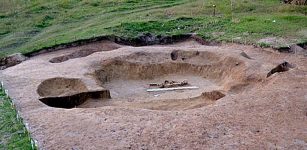49,000-Year-Old Artifacts Discovered In Warratyi Rock Shelter Fill A Gap In Australian Pre-History
MessageToEagle.com – Warratyi Rock Shelter is located about 340 miles north of Adelaide, Australia. Archaeologists excavating at the site for some time and now they have discovered several interesting 49,000-year-old artifacts that can help to fill a gap in Australian pre-history.
It is believed that Warratyi Rock Shelter the oldest archaeological site in the southern interior and one of the oldest on the continent. From historical perspective it is without doubt a place full of archaeological treasures that give much a better knowledge of the presence of people in this part of the world.
Giles Hamm, an archaeologist at Melbourne’s La Trobe University discovered the cave about 6 years ago. He was initially looking for prehistoric rock art when he stumbled up the cave. When he entered it he saw its roof was black. It was a sign of ancient campfire. There was also a pit and the soil was full of prehistoric artifacts and animal bones. Obviously this was once home to a number of people a long time ago.
The oldest deposits in the cave date back to 49,000 years ago, not too long after the first humans are thought to have arrived in northern Australia. That means people migrated to the southern part of the continent over a relatively short time span.
During recent excavations scientists have unearthed several valuable artifacts. One of them is a 40,000-year-old needle that scientists think could be Australia’s oldest bone tool. Inside the Warratyi Rock Shelter there were also spears and blades. These stone tools are 10,000 years older than similar tools found elsewhere in Australia.

In addition, scientists also discovered red ochre and white gypsum powder that might have been used as pigments for body painting.

Also in the cave is a bone specimen from the biggest marsupial that ever lived, the wombat-like creature Diprotodon optatum, and egg shells from the huge flightless bird Genyornis newtoni.
According to Hamm, humans kept coming back to the site for tens of thousands of years, likely because it was near resource-rich springs with water, vegetation, and animals like wallabies and lizards for hunting.

Could the artifacts discovered in Warratyi Rock Shelter offer enough evidence humans arrived on the continent much earlier than previously thought?
See also:
Aboriginal People Inhabited Australia Before The Mungo Man – New Study Reveals
Australia’s Pilbara Rock Art Older Than The Ice Age
Stunning Discovery Of 20,000-Year-Old Rare Hand Stencils In Sydney, Australia
The most accepted scientific theory stated that people arrived in Southeast Asia around 70,000 years ago. From there, about 50,000 years ago they traveled to Australia and this was the beginning of the modern Aboriginal population. However, with these new clues in mind, scientists will now be able to fill in the missing gaps in Australian pre-history.
In their science paper, Hamm and his colleagues write that their “evidence shows that people not only settled in the arid interior within a few millennia of entering the continent9, but also developed key technologies much earlier than previously recorded for Australia and Southeast Asia.
MessageToEagle.com
Expand for references









